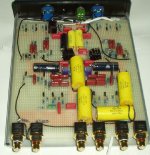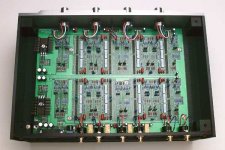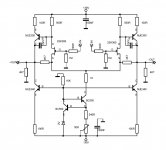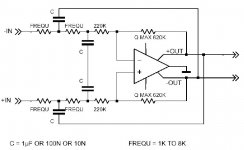negative
"reverse engineering" has nothing to do with positive or negative.
As the wheel is invented already, everything in audio electronics,
especially active Xovers using Sallen Key filters is kind of R.E.
Man could easily get blasphemous thoughts about NP himself doing "reverse engineering".
(dont kill me just kidding)
What I am a little bit disappointed at is the fact that our beloved
hero Grey Rollins put so much time into the zentillionth version
of "how does a filter work" adding "simplified schematics".
Even the schematics in NPs owners manual is way more detailed!
Uli


PS: I like name Xenover!
macka said:What, negative engineer a masterpiece three years in the making, "Are you kidding".
"reverse engineering" has nothing to do with positive or negative.
As the wheel is invented already, everything in audio electronics,
especially active Xovers using Sallen Key filters is kind of R.E.
Man could easily get blasphemous thoughts about NP himself doing "reverse engineering".
(dont kill me just kidding)
What I am a little bit disappointed at is the fact that our beloved
hero Grey Rollins put so much time into the zentillionth version
of "how does a filter work" adding "simplified schematics".
Even the schematics in NPs owners manual is way more detailed!
Uli



PS: I like name Xenover!
Uli,
I think the best is yet to come, variable everthing I mean.
Ain't ever there been a diy crossover like that now has there.
Except the commercial version of NP.
"It certainly is true that the brighter of our readership can
reverse engineer an XVR1 from the owner's manual, which is
online at www.passlabs.com"
Well now, isn't that a neat and tidy job. That's a real work of Art. What do you think Fred, technically speaking of course?
I think it's beautiful and would be a real conversation piece with any audio buddy who comes over for a listen, assuming you are lucky enough to own an XVR1.
Mr Pass, was that one of the ones you had in your head for a while and did the layout straight from memory? (no disrespect intended).
macka
😉
I think the best is yet to come, variable everthing I mean.
Ain't ever there been a diy crossover like that now has there.
Except the commercial version of NP.
"It certainly is true that the brighter of our readership can
reverse engineer an XVR1 from the owner's manual, which is
online at www.passlabs.com"
Well now, isn't that a neat and tidy job. That's a real work of Art. What do you think Fred, technically speaking of course?
I think it's beautiful and would be a real conversation piece with any audio buddy who comes over for a listen, assuming you are lucky enough to own an XVR1.
Mr Pass, was that one of the ones you had in your head for a while and did the layout straight from memory? (no disrespect intended).
macka
😉
Attachments
case study
I did a "case study" on X ing a Sallen Key filter.
Frequency resistors should be 1k, 1k25, 1k6, 2k, 2k5, 3k16, 4k,
5k and 6k28 or so
Caps 1µF for 20 - 160 Hz, 100nF for 200 - 1k6 Hz and 10n
for 2k - 16k Hz
The gain device can be used either as input-, output- or
filter buffer as it works with about 27mA bias and is entirely
class A
Uli


I did a "case study" on X ing a Sallen Key filter.
Frequency resistors should be 1k, 1k25, 1k6, 2k, 2k5, 3k16, 4k,
5k and 6k28 or so
Caps 1µF for 20 - 160 Hz, 100nF for 200 - 1k6 Hz and 10n
for 2k - 16k Hz
The gain device can be used either as input-, output- or
filter buffer as it works with about 27mA bias and is entirely
class A
Uli



Attachments
Thanks Uli. Have you built this?
Is the Q determined by the ratio of the Q resistor? and the 220K input resistors the same way as for a conventional single ended Sallen-Key filter? (tring to combine what you have posted with Grey's info to compensate for a rising response tweeter.)
Is the Q determined by the ratio of the Q resistor? and the 220K input resistors the same way as for a conventional single ended Sallen-Key filter? (tring to combine what you have posted with Grey's info to compensate for a rising response tweeter.)
not yet
Thanks!
no its not built yet.
BTW there is a mistake in the gainstage:
those 560R resistors should be 680.
the Q resistor stems from the formula:220k x (3 - 1/Q)
I chose 220k as high as practical possible to not
interfere with the filter components since its the input
resistance.
I try to do a universal pcb where you can build a 24dB
2 way stereo xover with 4 identical pcb´s.
Uli


PS: the filter parts are to be calculated according
to the formulas for Sallen Key with equal components
Thanks!
no its not built yet.
BTW there is a mistake in the gainstage:
those 560R resistors should be 680.
the Q resistor stems from the formula:220k x (3 - 1/Q)
I chose 220k as high as practical possible to not
interfere with the filter components since its the input
resistance.
I try to do a universal pcb where you can build a 24dB
2 way stereo xover with 4 identical pcb´s.
Uli



PS: the filter parts are to be calculated according
to the formulas for Sallen Key with equal components
Uli,
your Q formula works out to be a little different than Grey's
Solving for Q I get Q=1/(3-(Rq/Rinput)).
Note - Grey has different nomenclature, what he calls Rfeedback you call Rq)
in the case where both resistors are equal, Grey's formula gives a Q of 1, yours .5. Is this because the input resistors are effectively in series? could you point me to a reference so I could try to understand how the formula is developed in the balanced case?
thank you
Bob
your Q formula works out to be a little different than Grey's
Solving for Q I get Q=1/(3-(Rq/Rinput)).
Note - Grey has different nomenclature, what he calls Rfeedback you call Rq)
in the case where both resistors are equal, Grey's formula gives a Q of 1, yours .5. Is this because the input resistors are effectively in series? could you point me to a reference so I could try to understand how the formula is developed in the balanced case?
thank you
Bob
difference
Not yet having read Grey´s article I think he refers to
non inverting amplification.
In fact is the gain of the gainstage 3 - 1/Q which leads
to 2 - 1/Q for the resistor from out to -in in non inverting
amlifiers when the other one is 1.
The case with inverting amps is a little bit different.
As the gain is 3 -1/Q the resistor is 3-1/Q!
Uli


Not yet having read Grey´s article I think he refers to
non inverting amplification.
In fact is the gain of the gainstage 3 - 1/Q which leads
to 2 - 1/Q for the resistor from out to -in in non inverting
amlifiers when the other one is 1.
The case with inverting amps is a little bit different.
As the gain is 3 -1/Q the resistor is 3-1/Q!
Uli



that was it - I missed the difference between non inverting and inverting gain.
Thanks for the education.🙂
Thanks for the education.🙂
tx
Thanks for the nice words
Uli


PS: I am a fan of equal steps heres the list for the frqu resistors
all in series:
1) 1k (defines 160Hz)
2) 249R
3) 348R
4) 402R
5) 499R
6) 698R
7) 806R
8) 1k
9) 1k3
10)1k69
sum: 7992R or an error of 0.1%
Thanks for the nice words

Uli



PS: I am a fan of equal steps heres the list for the frqu resistors
all in series:
1) 1k (defines 160Hz)
2) 249R
3) 348R
4) 402R
5) 499R
6) 698R
7) 806R
8) 1k
9) 1k3
10)1k69
sum: 7992R or an error of 0.1%
Did you run any simulation on crossover slopes? I noticed in Aleph X, that if I placed single series caps at the input (both positive and negative side), the slope was 12dB and not 6dB as I expected.
no sim
Hi Peter,
no I did not simulate this.
I made the drawing a couple of hours ago.
But I will do a p to p prototype next week.
I do not have a trusty sim.
Uli


Hi Peter,
no I did not simulate this.
I made the drawing a couple of hours ago.
But I will do a p to p prototype next week.
I do not have a trusty sim.

Uli



I don't have a sim either, but it seems like using crossovers in balanced circuits compounds both sides for steeper slopes. So, using 6db on each side, provides total of 12 db in a circuit. At least that's what I observed last time (a HP filter at the input of Aleph X)
Your active stage looks very appealing.
Your active stage looks very appealing.
- Status
- Not open for further replies.
- Home
- Amplifiers
- Pass Labs
- Pass Diy High Low Pass Please






